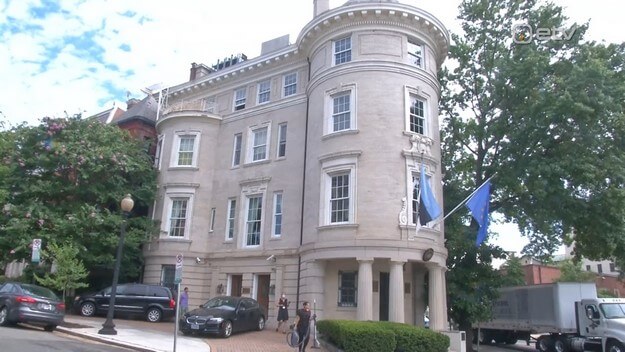
Estonian Embassy in Washington, DC. Source: ERR
Reconstruction work will start at the Estonian embassy in Washington, D.C., which will last for at least 18 months.
The renovation has been expected for years as power, heating and cooling systems are all considered old and dangerous.
The building in midtown Washington, D.C., was originally built in 1903 by a doctor as a personal residence, ETV’s weekly current affairs show “Aktuaalne Kaamera. Nädal” reported on Sunday.
The building on the corner of Massachusetts and Florida Avenues has been used by the Estonian embassy since 1994, but the procurement was not an easy task and needed some convincing.
Former president of Estonia and then-ambassador Toomas Hendrik Ilves recalled that 25 countries had tried to acquire the building for an embassy but had failed because the neighborhood’s locals opposed the idea for a simple reason – they did not want to lose parking spaces. However, Ilves did not back down and called for a meeting to be held with the locals.
Ilves, ambassador to the United States in 1993-1996, said: “I took with me Ann Tenno’s “Tallinn”, with pictures of the seven towers in Tower Square (Tornide väljak).
There is a tower in front of that building (in Washington, D.C. – ed.) as well, with a similar roof and then, while serving them tea and cookies, I opened the book and said: ‘Look, this tower in front of the building symbolizes and reminds us of our Old Town.'”
Ilves said the locals were fascinated by Tallinn’s Old Town, the Estonians gave up a few parking spots and the embassy was able to acquire the building.
However, that was just the beginning, as the building was not in great shape.
Ilves remembered: “Over the weekend, Peeter Reštšinski, who was a financial advisor, and I went through all the cheap stores in Virginia to purchase chandeliers and cheap furniture – which looked good but was not necessarily the most durable – but our budget was so small.”
The embassy’s work went on without many hiccups until 2001 when aged electrical wiring caused a fire.
Firefighters entered the building quickly and put out the fire but there was no cause for cheer.
Ambassador to the United States in 2000-2003 Sven Jürgenson said: “The situation was worse than it seemed because there was a lot of water damage were to computers and things, as well as the house itself, and all the previous problems also came together at once.”
The former ambassador said the embassy was initially glad the house was insured but that ended up making things more complicated in the end as the insurance firm provided a construction firm, who did a terrible repair job.
Jürgenson said: “Upstairs, on the second floor, we had a hall for receptions and such.
Later – because the walls and the ceiling were done, we could not see that another pipe had been placed – basically they had sawed through the ceiling truss and placed the pipe just there, meaning the hall was under risk of collapse.”
The embassy is facing similar problems now.
Electrical, heating and cooling systems are aged, humidity has given way to mold and the building’s construction is less than optimal.
Current Ambassador to the United States Jonatan Vseviov said: “The exterior will not change. It will remain beautiful going forward but it will be better, safer, more functional, modern and usable for diplomats.”
Over the years, the embassy staff has grown and the planning of the building has not kept up. In addition, IT capacity has to be improved.
He emphasized that the location is excellent because it is close to public authorities and institutions.
In addition, the building is in a eye-catching location and on a street with many other embassies.
The reconstruction works will last at least a year and a half and diplomats will move to temporary rooms for that time.
VES/ERR News
The temporary address of the embassy is :
1990 K St. NW,
STE 430,
Washington D.C., 20006












